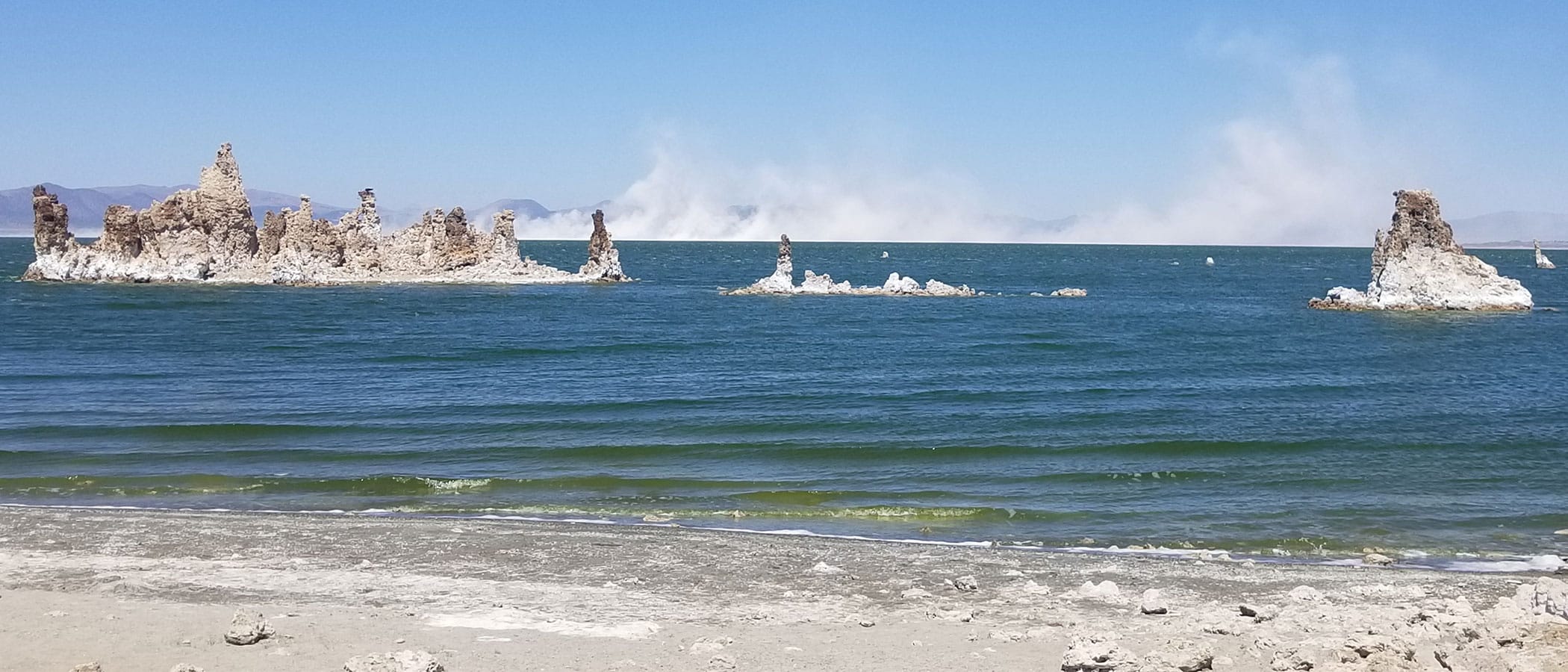
Drought forces reduced diversions, causes problems for nesting birds and air quality
Mono Lake is suffering from a severe drought. The lake has dropped more than three feet in elevation since 2019, exposing more lakebed. Dust storms have become more common on windy days. The third consecutive year of below-average snowpack has greatly reduced runoff into Mono Lake, impacting the lake’s salinity, shoreline, and wetlands. The landbridge between the mainland and Negit Island has expanded, leading hungry coyotes closer to ground-nesting California Gulls on nearby islets. Growing expanses of bright, salt-encrusted alkali flats and tufa shoals have emerged from a retreating lake. It looks like drought.
Record dry period
Around the state the theme is the same—not enough water. Rivers, lakes, streams, and groundwater are all diminished as California struggles through another series of drought years. The April 1, 2022, snow surveys measured Sierra Nevada snowpack at 37% of average. This follows the previous year’s 59%, and the year before that, 54% of average. While this multiyear trend has yet to top the drought of 2012–2016, consecutive years of well-below-average winter precipitation have been more frequent. According to research published in March using reconstructed tree ring data, California and eight other Western states are now coping with the driest period in the past 1,200 years.
Los Angeles’ one percent
This year Mono Lake dropped below 6380 feet in elevation, resulting in a mandatory reduction in stream diversions for the Los Angeles Department of Water & Power (DWP). On April 1, the start of the runoff year, stream diversions to Los Angeles were reduced to 4,500 acre-feet from 16,000 acre-feet—making this the second time in seven years that exports have been automatically reduced due to Mono Lake’s low level. From 2015 to 2017 Los Angeles adjusted to the same lower diversion allocation without issue. The 4,500 acre-feet of water that DWP plans to divert this coming year makes up less than one percent of Los Angeles’ total annual average water consumption.
Significantly larger reductions in water supply are affecting Los Angeles and Southern California due to statewide shortages. The Metropolitan Water District declared a Water Shortage Emergency Condition in April. The new declaration imposes a mandatory reduction that limits outdoor watering to one day a week with a complete cessation of outdoor watering by September 1 if water demand does not continue to decrease.
Problems at Mono Lake
A chronically low Mono Lake continues to create challenges for California Gulls. This year the Mono Lake Committee has installed a network of wildlife cameras to monitor the exposed landbridge for coyotes trying to reach the gull colony.
Mono Lake has the dubious distinction of being the largest active source of air pollution in the nation for particulate matter less than ten microns in diameter (PM-10). DWP’s historical excessive diversions dropped the lake’s level, exposing a ring of dry lakebed all around the lake that produces dust in the wind. The lower the lake, the worse this problem gets.
The Committee’s lake level forecast for the next 12 months indicates that Mono Lake will likely fall a foot and remain below 6380 feet next April 1. Neither the coyote predation threat nor air quality violations will be helped by these low lake levels.
More water needed
Today, Mono Lake still sits 12 feet below the mandated 6392-foot lake level—the level that would enhance lake productivity, submerge dust-producing areas, and eliminate the landbridge. The reduced diversions this year represent a significant boost to Mono Lake—11,500 more acre-feet of water will stay in the Mono Basin. While this totals around three inches of lake elevation, if allowed to continue regardless of lake level, diversion modifications add up over years. Just as a slowly dripping faucet can overflow a bathtub, a little less water diverted—and a little more flowing into Mono Lake—can begin raising the lake sooner.
This post was also published as an article in the Summer 2022 Mono Lake Newsletter. Top photo by Rose Nelson: Toxic dust storms, such as this one on April 9, 2022, occur when Mono Lake languishes at levels too low to submerge the dry lakebed exposed by DWP’s excessive diversions.
